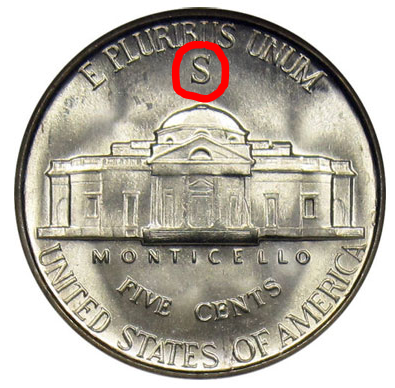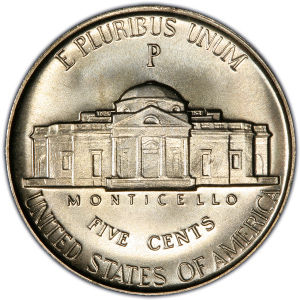What Are Coin Mint Marks? All About Mint Marks
Mint marks are tiny letters or symbols on coins that indicate where the coin was struck (i.e. where the coin was made). Mintmarks are used for “quality assurance purposes” in tracing the source of defective coins. Some of the earliest mint marks on coins were introduced by the ancient Greeks.
In the “Old Days,” mint marks were used to determine where an underweight or debased gold or silver coin came from, so the authorities knew who to put to death for stealing bullion (and it happened more often than you’d think!)

Example of a mintmark on a war nickel (red circle).
History of US Mintmarks
There have been a total of eight US mints since the first Mint was established in Philadelphia in 1792. Four of those are still operational: Philadelphia, San Francisco, Denver, and West Point.
#1: Mintmark: P - Philadelphia, PA (1792–present)
Philadelphia was the first US Mint established by the United States. Since it was the only source of coins in the beginning, a mintmark wasn't necessary. After branch mints were opened, it continued making coins with no mint mark.
Aside from the 1942-1945 silver “war nickels”, the P mintmark for the Philadelphia Mint did not appear on circulating US coins until the introduction of the Susan B. Anthony dollar coin in 1979. The Philadelphia mintmark has appeared on all denominations of US coins except the cent since 1980.

The 1942-P silver nickel has the "P" mint mark prominently displayed to distinguish it from nickels with the normal composition. (Photo: PCGS)
The First Branch Mints
The first three branch mints were authorized in 1835, to be located in Charlotte, NC; Dahlonega, GA; and New Orleans, LA. All began coining operations in 1838.
These branch mints (except New Orleans) were established in remote locations to refine and process local gold mine output into legal tender form. It was too dangerous to ship bulky gold ore by wagon through areas “overrun with Indians and bandits” to get to the seacoast, then by boat to the US Mint in Philadelphia for refining and assaying.
#2: Mintmark: C - Charlotte, NC (1838–1861)
The Charlotte Mint was a small mint established to process the gold from the nation’s first gold rush, centered around the Reed Mine. It only minted gold coins. It was seized by Rebel forces in 1861 when North Carolina seceded from the Union. The gold mines had mostly played out by the end of the Civil War, and the mint was never reopened.
#3: Mintmark: D - Dahlonega, GA (1838–1861)
The Dahlonega Mint was established on the Georgia frontier to process gold from land seized from the Cherokee Nation. A small mint like the Charlotte Mint, it only struck gold coins. Dahlonega was taken over by secessionist forces at the dawn of the Civil War and never reopened, as the local gold mines had run dry.
#4: Mintmark: O - New Orleans, LA (1838–1861), (1879–1909)
Unlike the mints in Charlotte and Dahlonega, the New Orleans Mint was a full-fledged mint, striking both gold and silver coinage. Its primary job was to supply silver coins to support the economy of the southern and western US (which ended at the borders of Iowa, Missouri, and Arkansas).
Like the other two original branch US Mints, the New Orleans Mint was closed down in 1861 at the start of the Civil War. The New Orleans Mint was refurbished and reopened in 1879 to produce Morgan silver dollars to meet the requirements of the Bland–Allison Act. Morgan dollar production ended in 1904. With its reason for existence gone, the New Orleans Mint was permanently closed in 1909.
#5: Mintmark: S - San Francisco, CA (1854–1955), (1968–present)
The San Francisco Mint was another branch US Mint opened to handle a gold rush—the famous 1849 California Gold Rush. The San Francisco Mint was responsible for supplying the monetary needs of the rapidly growing American West.
Much of the San Francisco Mint’s workload was taken over by the Denver Mint, resulting San Francisco being demoted from Mint to Assay Office in 1955. Coin production resumed during the coin crisis of 1964 and it regained its status as a US Mint in 1968. Most proof coins are now struck at the San Francisco Mint.
#6: Mintmark: CC - Carson City, NV (1870–1885), (1889–1893)
The Carson City Mint was established to process silver ore coming out of Nevada mines during the Comstock Silver Rush. Production never approached that of the other mints, so the coins it did strike went immediately into the cash-starved regional economy. This makes Carson City coins some of the rarest 19th-century US coins.

Due to their relative scarcity, coin collectors enthusiastically pursue any coins bearing the "CC" mint mark, like this 1890-CC half eagle gold coin. (Photo: PCGS)
The establishment and continued operation of the Carson City Mint was mired in politics. It was closed down in 1885 on orders of President Grover Cleveland. It was reopened in 1889 by the Benjamin Harrison administration before it was shut down for good in 1893 in the second Grover Cleveland administration.
#7: Mintmark: D - Denver, CO (1906–present)
The Denver Mint was originally established to process the gold from the Colorado Gold Rush. It opened in 1863 but had its Mint status and staff reduced as a cost-cutting measure in 1869, before minting a single coin.
.png)
Location of the mint mark on the reverse of a 1923-D Peace dollar silver coin.
The Denver location was classified as an Assay Office in 1869, not regaining its status as a US branch Mint until 1895. Design and construction of a new Denver Mint building began the same year but wasn’t ready for occupation until 1904.
The Denver Mint struck its first coin in 1906. It is now the largest single-location mint in the world and produces the majority of US circulating coinage.
#8: Mintmark: W - West Point Mint (1986–present)
The West Point Mint is the newest branch US Mint. Originally the US Silver Depository, the facility was built in 1938 on four acres of land previously owned by the US Military Academy. It was not officially designated a US Mint until 1988 but had been coining “no mintmark” cents and quarters since the mid-70s to help relieve pressure on the Philadelphia Mint.
The first coin to bear a W mintmark was the gold 1984 Los Angeles Olympics commemorative $10 coin. (This was also the first legal tender US gold coin since 1933.) This made West Point the first US Mint facility to use a mintmark before it was designated an official mint.
Finding Mint Marks on US Coins: Pre-1968 Mint Marks and Post-1968
During the 1964 coin crisis, the government decided to make coins less attractive to collectors by removing mint marks from all coins. When they returned in 1968, they were all placed on the coins’ obverse. But where were they before then? The short answer is “wherever the Mint decided worked best.”
CENTS
- Lincoln Wheat Cents (1909–1958): Obverse, under date.
- Lincoln Memorial Cents (1959–): Obverse, under date.
NICKELS
- Buffalo Nickel (1913-1938): Reverse, bottom center under “FIVE CENTS.”
- Jefferson Nickel (1938-1942): Reverse, between Monticello and right coin rim.
- Jefferson Silver “War Nickel” (1942–1945): Reverse, above Monticello. Included “P” mint mark for the first time.
- Jefferson Nickel (1946–1964): Original design resumed.
DIMES (Silver)
- Mercury Dime (1916–1945): Reverse, bottom next to the base of the olive branch.
- Roosevelt Dime (1946–1964): Reverse, bottom left of the torch.
QUARTERS (Silver)
- Standing Liberty Quarter (1916–1930): Obverse, bottom, above, and to the left of the date.Tiny mint mark between Liberty’s foot and the bottom left star.
- Washington Quarter (1932–1964 ): Reverse, bottom center underneath wreath.
HALF DOLLARS (Silver)
- Walking Liberty Half Dollar (1916–1947): Reverse, bottom left between rock and rim, beneath pine branch growing on rock.
- Franklin Half Dollar (1948–1963): Reverse, tiny mint mark top center above the yoke of the Liberty Bell, beneath the E in STATES.
Locations of Modern Mint Marks
“Modern” mint marks have been in the same place since 1968 unless the design of the obverse itself was changed. Modern circulating coins are only produced at the Philadelphia and Denver Mints.
MODERN CENTS
All Lincoln cents (except Philadelphia) display their mint mark below the date on the obverse. Except for proofs and special cents struck for coin sets, the D for the Denver Mint is the only mint mark on modern Lincoln cents.
- Lincoln Memorial (Modern) (1965–2008)
- Lincoln’s Bicentennial (2009)
- Lincoln Shield Reverse (2010–)
MODERN NICKELS
- Jefferson (1965–2003): Obverse, immediately after the date, next to Jefferson’s ponytail.
- Westward Journey (2004): Same as previous.
- Westward Journey (2005): New Type 3 right-facing Jefferson obverse. Mint Mark appears below LIBERTY and above date.
- Return to Monticello (2006–): New Type 4 Jefferson obverse, featuring a ¾ view of Jefferson facing right. Mint mark appears below the date.
MODERN DIMES
- Roosevelt (1965–): Obverse, lower right above date and below FDR’s neckline.
MODERN QUARTERS
- Washington (1965–1998): Obverse, right, next to Washington’s ponytail.
- Bicentennial (1975–1976): Same as 1965–1998 Washington quarter.
- 50 States and Territories (1999–2009): New obverse with shifted inscriptions. Mint mark remains in the same place.
- America The Beautiful (2010–2021): Same as 50 States quarters.
- Washington Crossing the Delaware (2021): Reversion to 1965–1998 obverse.
- American Women Quarters (2022–2025) New right-facing obverse by Laura Fraser, mint mark on the right side beneath the date.
MODERN HALF DOLLARS
All Kennedy half-dollars have borne their mint mark below the left tip of Kennedy’s neckline. The US Mint stopped striking Kennedy half dollars for circulation from 2001 to 2020.
- Kennedy silver clad (1965–1970): 40% silver content.
- Kennedy copper-nickel clad (1971–)
- Kennedy Bicentennial (1976)

Lettered Edge of the American Innovation Dollar Coins. All US dollar coins since 2009 have had lettered edges displaying the year, mint mark, and E PLURIBUS UNUM. (Photo: United States Mint)
MODERN DOLLAR COINS
- Eisenhower (1971–1978): Obverse, tiny mint mark between date and Eisenhower’s neckline.
- Eisenhower Bicentennial (1976): Same as regular mintage.
- Susan B Anthony (1979–1981, 1999): Obverse, left side over Anthony’s right shoulder.
- Sacagawea (2000–2008): Obverse, below date.
- Native American (2009–): On a lettered edge, with the year and E PLURIBUS UNUM.
- Presidential Dollar (2007–2016): Same as Native American Dollar (IN GOD WE TRUST moved from the edge to the obverse in 2009).
- American Innovation (2018–2032): Same as 2009-2016 Presidential Dollars.
Sources for images used: PCGS CoinFacts, United States Mint
Learn more about U.S. coins from the numismatic experts at Gainesville Coins:
Collector Resources for Understanding the Hobby of Collecting Coins
Anatomy of a Coin: How to Identify Coins On Sight
Most Asked Questions About US Mint Coins: Buyer's Guide
Coin Collecting For Kids: How to Get Started

Steven Cochran
A published writer, Steven's coverage of precious metals goes beyond the daily news to explain how ancillary factors affect the market.
Steven specializes in market analysis with an emphasis on stocks, corporate bonds, and government debt.
